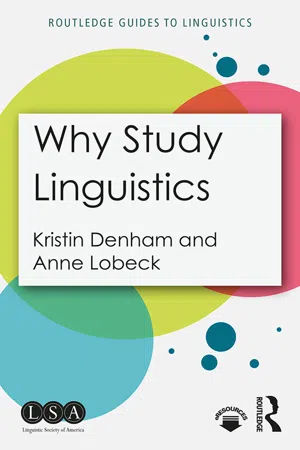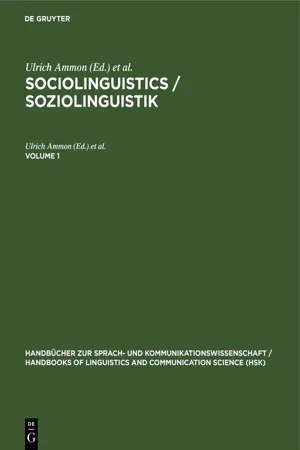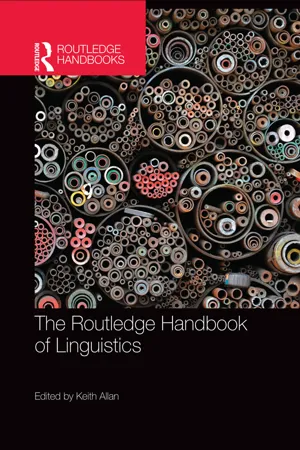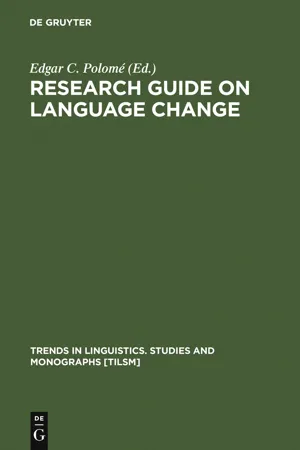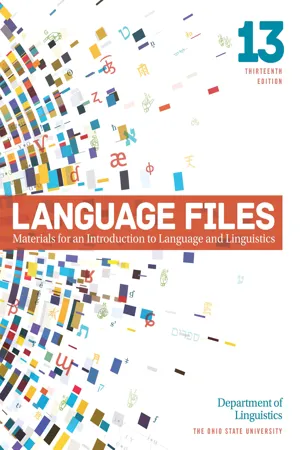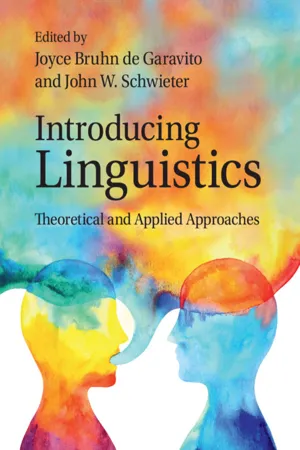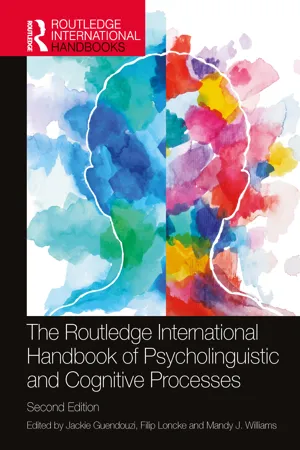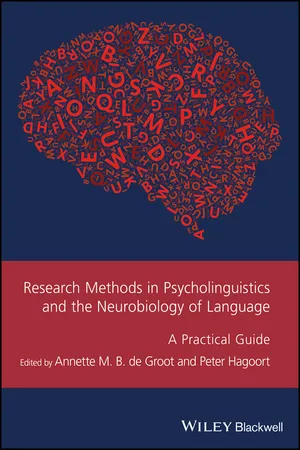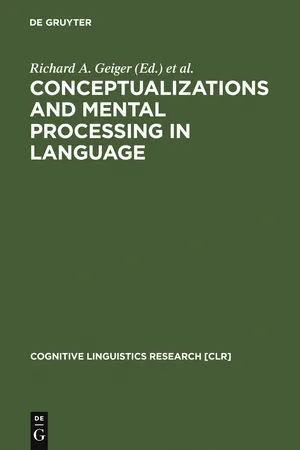Languages & Linguistics
Psycholinguistics
Psycholinguistics is the study of how language is processed and produced in the human mind. It explores the cognitive processes involved in language comprehension, production, and acquisition, as well as the neurological and psychological factors that influence language use. This interdisciplinary field draws on insights from psychology, linguistics, neuroscience, and cognitive science to understand the complex relationship between language and the human mind.
Written by Perlego with AI-assistance
Related key terms
1 of 5
10 Key excerpts on "Psycholinguistics"
- eBook - ePub
- Kristin Denham, Anne Lobeck(Authors)
- 2018(Publication Date)
- Routledge(Publisher)
9 Studying language in the brain PsycholinguisticsAs you read about in earlier chapters, a central question of linguistics is how we acquire knowledge of language as children. A great deal of evidence suggests that humans are born with the capacity to acquire language and are equipped with some inherent knowledge of language, making the complex task of acquiring language relatively easy, regardless of intellectual capacity, circumstances, or the language that one is exposed to. Psycholinguistics, or the psychology of language, encompasses a great many aspects of the study of language. Some claim, as Noam Chomsky himself has (1972), that linguistics itself can be considered a branch of psychology since psychology is the study of the mind and behavior, and the study of language is an important component of understanding the human mind and human behavior. Psycholinguistics is typically understood to include the study of the acquisition of language by children (sometimes known as L1 acquisition); the processing of language at all levels (phonological, morphological, syntactic, and at the discourse level); and the storage and access of words in the lexicon. Experimental methodologies common in psychology, such as eye-tracking, reaction time, and neural imaging, are often used to assess various aspects of language production, processing, and storage.First language acquisitionChild language acquisition provides us with a great deal of evidence for our innate capacity for language. Neuropsychologist Eric Lenneberg compares the acquisition of language to innate abilities in other species, including eyesight in cats and flight in birds. All such behaviors, he argues, share the following characteristics of biological behavior (Lenneberg, 1967): - eBook - PDF
- Ulrich Ammon, Norbert Dittmar, Klaus J. Mattheier, Peter Trudgill, Ulrich Ammon, Norbert Dittmar, Klaus J. Mattheier, Peter Trudgill(Authors)
- 2020(Publication Date)
- De Gruyter Mouton(Publisher)
V. Neighbouring and Auxiliary Disciplines Nachbar- und Hilfswissenschaften 60. Psycholinguistics 1. Language Acquisition 2. Language Comprehension 3. Language Production 4. Literature (selected) Whereas sociolinguistics investigates the inter-action of social factors, varying largely in space and time, with language knowledge and language use in individuals and groups, psy-cholinguistics is concerned with the general, intraindividual aspects of the human language faculty in language processing in real time. This faculty is assumed to have a modular structure. It consists of a number of autono-mous but interacting components: linguistic knowledge as represented by the grammar of a particular language and systems for the pro-duction, comprehension, and acquisition of language. The major concern of present day Psycholinguistics is to characterize the precise structure of these different components and to determine the details of their interaction. Research focuses on the universal properties of the components and the principled and li-mited variations they undergo when they enter into contact with a particular language. Re-cently, the question of why human languages and the language processor take the form they do has become a central issue. The charac-terization of the notion possible human lan-guage is studied in connection with the no-tions of parsability and learnability (Ber-wick/Weinberg 1984). More specifically, the question is whether particular properties of human languages are derivable from proper-ties of the human language processor or vice versa (Frazier 1985; Crain/Fodor 1985). The question of how the components of the human language faculty are physically represented in the brain is the subject matter of neurolinguis-tic research. - eBook - ePub
- Keith Allan(Author)
- 2015(Publication Date)
- Routledge(Publisher)
Psycholinguistics Language and cognition Matthew J. Traxler18.1 Introduction: Why is Psycholinguistics significant?
We are what we do. What psycholinguists do is apply research methods derived mainly from the discipline of psychology to understand human behavior, thought, and neural processes as they relate to language function. Mainly because psycholinguists are a diverse bunch, they bring a diverse set of methods to the task of understanding how humans produce and understand language. Researchers in the field of Psycholinguistics include psychologists and linguists (of course, so long as said linguists are interested in mind, brain and behavior), but also computer scientists, anthropologists, sociologists, philosophers, statisticians, historians, literary scholars and a variety of other disciplines. Psycholinguistics, therefore, provides a prototypical example of a multidisciplinary approach to science.Psycholinguistics is a science, because psycholinguists apply the scientific method (observe, hypothesize, test, repeat), and it is as data-driven as any other scientific enterprise. The study of language in psychology at its inception was characterized by armchair philosophy, but those days are long gone. Beginning students of Psycholinguistics are often surprised that it is a science, and that they therefore need to learn how to apply the scientific method to language. This involves understanding how experiments are designed, how data are collected and analyzed, and how the human nervous system works.Psycholinguists have made numerous contributions to our theoretical understanding of how people represent knowledge about language, how people access and use this knowledge in real time to produce and understand language, how the human species acquired its current range of language abilities, and how neural systems support language function. These contributions are important not only because understanding how language works is a necessary part of understanding how human beings work, but also because there is a close relationship between language disorder and other kinds of mental disorder. This close connection between language function and overall mental function most likely reflects bi-directional causal relationships from language to non-linguistic cognition, and vice versa. When non-linguistic aspects of cognition (such as attention, executive control or working memory) go wrong, aspects of language function can go wrong. When aspects of language function go wrong (as in Specific Language Disorder, dyslexia and aphasia), this has consequences for the social and emotional functioning of the individual, as well as effects on educational and economic outcomes. Here is an example of each type of causal relation: - eBook - PDF
- Edgar C. Polomé(Author)
- 2011(Publication Date)
- De Gruyter Mouton(Publisher)
Psycholinguistics: A research review Car lota S. Smith The field of Psycholinguistics deals with the psychological processes involved in language. Important subfields include language perform-ance (encoding and decoding), the study of memory, speech perception and production, language development and acquisition. Other inter-disciplinary fields such as neurolinguistics and reading will not be covered in this survey. 1. Language performance: words, sentences, texts Psycholinguists studying performance are interested in the processes and structures that underlie it — the steps from sound to meaning, and vice versa. In trying to get at these, researchers are forced to rely largely on indirect techniques. Typically a subject is given a task with a verbal stimulus and a direct behavioral response; the patterns of reaction or response times (RTs) are interpreted on the assumption that some time is taken up by linguistic processing. Differences in RTs lead to inferences about processing. Obviously experimental tasks and stimulae are themselves important variables in this kind of research. 1.1. Lexicon A number of questions in this field concern the lexicon, its structure and availability to the language user. Among the important questions are the following: How is the mental lexicon organized, and what is the internal structure of lexical entries? What are the processes invoked in finding a word in the lexicon? Is linguistic processing 176 Carlota S. Smith relatively autonomous, with separate components for different types of processing? The mental lexicon appears to be organized according to the pho-nological form of words: Fay and Cutler (1977) cite patterns of spontaneous speech errors as evidence for this claim. Studies of rhyme detection suggest that both phonological and orthographic information is available in lexical representations (Donnenwerth-Nolan et al. 1981; Tanenhaus et al. 1980; Stanners — Forbach 1973). - eBook - PDF
Language Files
Materials for an Introduction to Language and Linguistics, 13th Edition
- Department of Linguistics(Author)
- 2022(Publication Date)
- Ohio State University Press(Publisher)
C H A P T E R 9 Psycholinguistics © 2015 by Julia Porter Papke 370 F I L E 9.0 How Do Our Minds Understand and Produce Language? Previous chapters have examined how languages work, from combining sounds to inter- preting utterances in the context of a conversation. But how does your mind actually learn and implement the rules of language? From the hundreds of thousands of words we know, we pick just the right ones and quickly arrange them into grammatical patterns to convey our intended meaning. How are such complex processes carried out so quickly and effortlessly? What can we learn from the mistakes that we make with language? How do we use the patterns of changing air pressure that leave our mouths and hit our ears to make ideas appear in each others’ minds? Psycholinguistics investigates how the intricate linguistic processes described in the other chapters of this book are actually carried out in our minds as we produce and comprehend language. Neurolinguistics is the study of language and the physical brain. To discover where and how the brain processes language, we need to know where the language centers of the brain are and how information flows between these areas. Experimental techniques that allow us to see the brain in action play a large role in neurolinguistics, as do studies of pa- tients with language disorders. Contents 9.1 Language and the Brain Discusses physical features of the brain and their functions, illustrates physical aspects of how the brain processes language, and introduces the concepts of lateralization and contralateralization. 9.2 Language Disorders Describes some common types of language disorders and discusses disorders in users of both spoken and signed languages. 9.3 Speech Production Discusses models of speech production and shows how production errors in sign and speech can inform such models. - eBook - PDF
Introducing Linguistics
Theoretical and Applied Approaches
- Joyce Bruhn de Garavito, John W. Schwieter(Authors)
- 2021(Publication Date)
- Cambridge University Press(Publisher)
To learn more about computational approaches to language, see Chapter 17 Computational Linguistics.. SUMMARY Psycholinguistics is the study of the cognitive processes and mental representations that are involved in language production, comprehension, and acquisition. In this chapter, we have discussed several theoretical models of speech production and comprehension. You have learned that both bottom-up and top-down processing are involved in language. 531 Exercises In sound processing, we use auditory information in the speech signal to process linguistic input. Motor theory states that we also use our knowledge of sound articulation and reading lips to comprehend speech. Two important models that explain sound processing and lexical access are the TRACE model and the cohort model. While the TRACE model argues that several levels of processing – feature level, phoneme level, word level – are all said to be active, the cohort model posits that a cohort of words with the same initial sound will be first analyzed followed by a process of elimination until one word is left as the correct target word. We focused much on the mental lexicon and lexical access in our conversation about word processing. The mental lexicon is the dictionary in your mind which contains word characteristics including their phonological, syntactic, and semantic properties. The search model explains how words from the mental lexicon are recognized. There are factors, however, that could affect this such as word frequency, ambiguity, how recently the word was last accessed, and its phonological neighborhood. When a speaker is temporarily unable to retrieve a word from the mental lexicon, we say that he/she is in a tip-of-the-tongue state. In sentence processing, parsing is the process of determining the grammaticality of words and phrases and assigning them into their appropriate grammatical category. - Jackie Guendouzi, Filip Loncke, Mandy J. Williams, Jackie Guendouzi, Filip Loncke, Mandy J. Williams(Authors)
- 2023(Publication Date)
- Routledge(Publisher)
Some basic considerations Jackie Guendouzi and Filip LonckeDOI: 10.4324/9781003204213-1Introduction
As noted in the first edition we did not intend this collection to be an extensive survey of the field of Psycholinguistics. Rather, the aim of the book was to provide a tutorial resource that combines research from Psycholinguistics and cognitive sciences with the field of communication disorders. The information presented here does not require prior knowledge but it does assume some basic knowledge in the area of linguistics or cognitive sciences. The second edition includes 18 updated or revised chapters that include new authors. However, several of the original chapters remain because they reflect seminal areas of knowledge in the fields of Psycholinguistics and communication disorders. Sadly, since the first edition, Heather van der Lely and Ursula Bellugi both passed away. Van der Lely’s research (see Chapter 20 ) was influential in generating debate in the area of Specific Language Impairment (SLI) while Bellugi’s phenomenal career pioneered work that aligned cognitive science with the study of sign language (see Chapter 32 ). In both cases, their contributions to this book reflect their influence within their respective areas of research and make for compelling reading.The field of Psycholinguistics has yielded many diverse and competing theories over the years; some more than others have dominated language research. As seen in this text, there are multiple approaches to the question of how we process language. Readers should draw their own conclusions as to the robustness of specific models or theories; exploring theoretical questions is an ongoing process that rarely arrives at a definitive answer, there is always more to discover. As with the first edition, we feel it is helpful to start the introduction by providing some historical context to the field of Psycholinguistics and its relationship with communication disorders.- eBook - ePub
- Annette M. B. de Groot, Peter Hagoort, Annette M. B. de Groot, Peter Hagoort(Authors)
- 2017(Publication Date)
- Wiley-Blackwell(Publisher)
The picture for Psycholinguistics is largely similar. With the notable exception of language acquisition research (e.g, Bowerman & Brown, 2008; Slobin, 1985), most psycholinguistic research has been done with speakers of English, or other European languages. Jaeger and Norcliffe (2009), for instance, found sentence production research relies on data from only 0.6% of the world’s languages (cf. Norcliffe, Harris, & Jaeger, 2015). This is problematic because English, and other “Standard Average European” languages, do not adequately portray the world’s linguistic diversity (Dahl, 2015), and this leads researchers to disproportionately focus on patterns imposed by Eurocentric linguistic traditions (Whorf, 1944; Gil, 2001). Similarly, the sociodemographic characteristics of speakers typically participating in psycholinguistic experiments—that is, “WEIRD”: Western, Educated, Industrialized, Rich and Democratic—make them unusual when compared to the rest of the world (Henrich, Heine, & Norenzayan, 2010; Majid & Levinson, 2010). For instance, there is a strong focus on monolinguals in psycholinguistic studies, which ignores the fact that worldwide multilingualism is rampant. In sum, an approach restricted to a largely homogenous sample fails to recognize the world’s vast cultural and linguistic diversity (Evans & Levinson, 2009; Malt & Majid, 2013), tacitly assuming psycholinguistic universalism.In reality differences in grammatical and semantic structure have differential consequences for the encoding and decoding of utterances (e.g., Norcliffe, Harris, & Jaeger, 2015; Levinson, 2012), and can affect general cognitive processes (e.g., Majid et al., 2004; Wolff & Holmes, 2011). We focus here on the lesser‐known languages spoken outside urban areas, but since cross‐linguistic Psycholinguistics is in its infancy, even relatively well‐described languages (e.g., Tagalog), can offer novel insights (e.g., Sauppe et al., 2013).What Does It Entail? Best Practice
Each language presents a unique set of challenges to a researcher. The requirements and procedure followed in a field study will thus vary considerably from place to place depending on a number of practical and theoretical issues related to the field site logistics, sociocultural and linguistic background of the study population, state of language documentation, research questions, and so on. There are a number of excellent guides (e.g., Bowern, 2008; Crowley, 2007; Sakel & Everett, 2012), and handbooks (e.g., Gippert, Himmelmann, & Mosel, 2006; Newman & Ratliff, 2001; Thieberger, 2011) on linguistic fieldwork, so we will only flag some key general issues, focusing specifically on psycholinguistic methods in the field.The first prerequisite for successful psycholinguistic research in the field is familiarity with the language and culture under study. What this means in practice is long‐term involvement with the community. If a language has not been previously studied, fieldwork will also require doing basic description to provide the groundwork for pursuing more advanced questions. If, on the other hand, a sufficiently good grammatical description already exists, getting to know the language will be easier. Knowing the language and culture is crucial not only because it enables you to interact with speakers and carry out experiments, but also to ensure you do not overlook important links. Since it is impossible to determine a priori how an under‐described language works, fieldworkers cannot allow themselves the luxury of being interested only in syntax or only in morphology, but need a general mastery of the “whole language” (Hyman, 2001), and an understanding of its fit within the culture. For instance, sentence formulation is affected by word order, but at the same time it might also be driven by verb morphology (Norcliffe et al - Richard A. Geiger, Brygida Rudzka-Ostyn, Richard A. Geiger, Brygida Rudzka-Ostyn(Authors)
- 2011(Publication Date)
- De Gruyter Mouton(Publisher)
That they are cognitive-scientific means that multidisciplinarity involving the fields of linguistics, psychology and artificial intelligence is necessary. At the same time, the computational realizability and psychological reality of the approaches are essential. Together, they lead to the anteriority of process thesis, which states that process deploys and determines structure. In this light the much-debated competence-performance distinction is redefined, with competence becoming processing competence, a set of processing universale, strong psychological constraints using and creating knowl-edge structures without being determined by them. This set of con-straints defines language processing (viz. understanding) as a robust, in-cremental, lexically-driven, semantic/pragmatic interactive process. Modelling this process in a cognitive-scientific perspective has proved not only possible, but also rich in potential explanatory power. To end with a quote from Briscoe's (1987: 227) conclusion that stresses this aspect: A more detailed understanding of the psychological pro-cesses and mechanisms which underlie language acquisition, production, and comprehension offers the possibility of considerably increasing our understanding of language, both by bringing to light new facts (such as correlations between prosody, parsing strategies and ambiguity) and by offering insightful explanation for such facts. Notes 1. See Collins (1977), Norman (1981), Kintsch et al. (1984), Gardner (1985) for similar definitions of Cognitive Science. 164 Geert Adriaens 2. See e.g. Winograd (1983 and passim), Schänk & Riesbeck (1981), Mar-cus (1980) for examples of AI research in the area of natural language processing. 3. See e.g. Bresnan (1982), Berwick & Weinberg (1984), Naumann (1988) or any issue of Proceedings of the Association for Computational Linguistics (ACL), or of the International Conference on Computational Linguistics (COLING).- eBook - ePub
- Harlan L. Lane, Francois Grosjean(Authors)
- 2017(Publication Date)
- Psychology Press(Publisher)
3Psycholinguistics of Sign Language 1François GrosjeanNortheastern UniversityIn this chapter we review a number of studies pertaining to the Psycholinguistics of sign language. We begin by summarizing those studies whose goal was to determine if sign language is as effective as spoken language for communication. Having responded in the affirmative to this question, we present an account of the studies that have demonstrated the psychological reality of certain aspects of the structural organization of sign language as it is described by linguistics. Next we study the production of sign language—what it has in common with spoken language and in what ways it is different—as well as the perception of sign: psychophysics of rate, iconic memory, and on-line processing of signs presented individually and in sentential context. We end the chapter with a résumé of studies bearing on the role of memory in sign language communication.Because our space is limited and because of a lack of systematic research, this chapter will not treat the following aspects of Psycholinguistics of sign language: communication between signers of different sign languages, the role of the figurative aspect of sign language and its perception and memorization, perception and production of contrived signing systems (such as Sign English), spoken—sign language bilingualism, and the acquisition of sign language as a native language. The latter topic is reviewed by Hoffmeister and Wilbur elsewhere in this book. Two further preliminaries: Although most of the studies that we cite are concerned with American Sign Language (ASL), we believe that the processes of production, perception, and memorization that will be examined are for the most part descriptive of other sign languages as well. Moreover, these processes should be compared to those for oral language and consequently we will attempt to clarify as far as possible the relations between the activities of the signer/observer and those of the speaker/listener. Psycholinguistics is addressed, after all, to the perception, understanding, and production of all languages, whether spoken or sign. No model of linguistic performance can be complete unless it describes those aspects of encoding and decoding that are specific to the modality of communication, oral or visual, and those that are common to all languages whatever their modality of perception and production.
Index pages curate the most relevant extracts from our library of academic textbooks. They’ve been created using an in-house natural language model (NLM), each adding context and meaning to key research topics.
